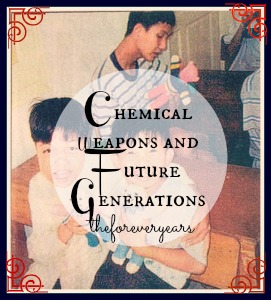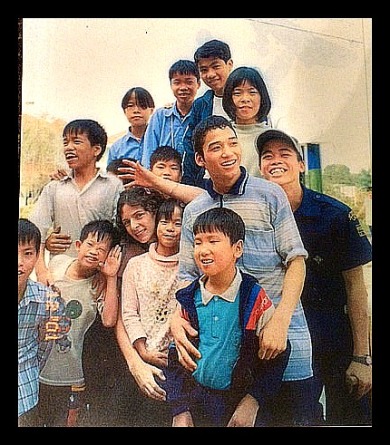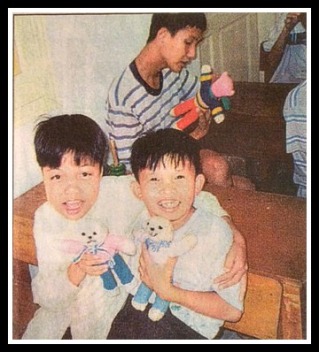By Kirsteen McLay-Knopp
The following article was originally published in the “Otago Daily Times” newspaper, May 1-2, 2004, about six months after I returned to New Zealand from Vietnam. Such stories are always relevant to child advocacy: the choices of our past and present (particularly in situations of war) can continue to affect those born long afterwards. Before continuing to my article, I would like to include some information from Wikipedia about attempts so far to prevent the use of chemical weapons, as well as a further article by Rania Khalek about recent use of chemical weapons in Gaza and a picture with text from http://shaunynews.com/2014/07/15/israel-is-using-chemical-weapons-now-against-palestine/
The following is from Wikipedia, the free encyclopedia:
The Chemical Weapons Convention
Intergovernmental consideration of a chemical and biological weapons ban was initiated in 1968 within the 18-nation Disarmament Committee, which, after numerous changes of name and composition, became the Conference on Disarmament (CD) in 1984. On 3 September 1992 the Conference on Disarmament submitted to the U.N. General Assembly its annual report, which contained the text of the Chemical Weapons Convention. The General Assembly approved the Convention on 30 November 1992, and The U.N. Secretary-General then opened the Convention for signature in Paris on 13 January 1993. The CWC remained open for signature until its entry into force on 29 April 1997, 180 days after the deposit of the 65th instrument of ratification (by Hungary). The convention augments the Geneva Protocol of 1925 for chemical weapons and includes extensive verification measures such as on-site inspections. It does not, however, cover biological weapons.
|
Convention on the Prohibition of the Development, Production, Stockpiling and Use of Chemical Weapons and on their Destruction
|
| Participation in the Chemical Weapons Convention:Six UN states are not party: Angola, Burma, Egypt, Israel, North Korea and South Sudan. |
The Chemical Weapons Convention (CWC) is an arms control treaty which outlaws the production, stockpiling, and use of chemical weapons and their precursors. The full name of the treaty is the Convention on the Prohibition of the Development, Production, Stockpiling and Use of Chemical Weapons and on their Destruction and it is administered by the Organisation for the Prohibition of Chemical Weapons (OPCW), an intergovernmental organization based in The Hague, Netherlands. The treaty entered into force in 1997.
The parties’ main obligation under the convention is to prohibit the use and production of chemical weapons, as well as the destruction of all chemical weapons. The destruction activities are verified by the OPCW.
As of September 2013, around 82% of the declared stockpile of chemical weapons has been destroyed.[5][6] The convention also has provisions for systematic evaluation of chemical and military plants, as well as for investigations of allegations of use and production of chemical weapons based on intelligence of other state parties.
As of October 2013, 190 states have given their consent to be bound by the CWC. Two of the remaining six states, Israel and Myanmar, have signed but not ratified the agreement.[1] Most recently, Syria deposited its instrument of accession to the CWC on 14 September 2013 and agreed to its provisional application pending entry into force on 14 October 2013.[7]
A further atricle of interest–
Use of chemical weapons recently in Gaza:
Israel firing experimental weapons at Gaza’s civilians, say doctors
Submitted by Rania Khalek on Tue, 07/15/2014 – 10:55
Doctors treating patients in Gaza have accused Israel of using experimental weapons on Palestinian civilians.
Addressing reporters at a press conference on Sunday, Youssef Abul Resh, undersecretary of the health ministry in Gaza, said, “Medical teams have registered injuries consistent with those caused by DIME [dense inert metal explosives] and other banned weapons.”
He added, “Israel has mercilessly targeted Palestinian civilians, leaving many of them with life-threatening injuries and future handicaps.”
In the last week, Israeli airstrikes have killed more than 190 people, eighty percent of them civilians, including at least 34 children.
Using Gaza as a laboratory
DIME munitions were developed by the US Air Force in 2006 and have since been tested repeatedly on the people of Gaza, who have long served as involuntary lab rats for Israel’s weapons industry.
DIME bombs contain tungsten, a cancer-causing metal that helps to produce incredibly destructive blasts which slice through flesh and bone, often decapitating the lower limbs of people within the blast radius.
Renowned Norwegian doctor Mads Gilbert, who witnessed the horrific injuries caused by DIME bombs during Israel’s 2009 Gaza onslaught, told The Electronic Intifada over the phone from al-Shifa hospital in Gaza City that patients are showing up with DIME-related injuries.
“A good number of the injuries seen here are consistent with the use of dense inert metal explosives, or DIME, that we saw during the 2009 attack and also in 2006,” said Gilbert. “The bodies are pretty much destroyed by enormous energy released by the explosives that are shot near them or at them.”

July 15th 2014: Exploding DIME (dense inert metal explosives) in Gaza
A Norwegian doctor in the besieged Gaza Strip has strongly criticized Israel for using cancer-inducing bombs against Palestinian civilians. Dr. Erik Fosse told Press TV that the majority of patients hospitalized in Gaza are civilians injured in attacks on their homes and about thirty percent of them are children.
Source for above picture and text:
http://shaunynews.com/2014/07/15/israel-is-using-chemical-weapons-now-against-palestine/
My Article:
Living With the Long Arm of Agent Orange
By Kirsteen McLay-Knopp
…When we arrived home we had a big welcome on the Marae. That welcome was different from the one we got from everyone else, where the hostility really brought us down to earth. We had no formal recognition from the government. We were humiliated by the protest groups. Some of us began to die from the chemicals… I get the cough now and then. Cancer. Yeah, it got me too—Agent Orange. –From The Uncle’s Story by Witi Ihimaera.

A third generation is now being affected by Agent Orange, the dioxin cocktail dropped over wide ares of Vietnam by the United States during the late 1960s and early 1970s.
During the American-Vietnamese war (which also involved New Zealand, South Korea, the Phillipines, Taiwan and Australia), Agent Orange was used to defoliate tropical forests. The aim of this was to reveal the tunnels and other hiding places of the Viet Cong, the Communist North Vietnamese who, under Ho Chi Minh, defeated the Southern forces, the Americans and their supporters in April 1975.
Now, so many years after the war’s end, the effects of Agent Orange on human beings are being compared, by some, with those of the nuclear bombs dropped on Hiroshima and Nagasaki, in Japan, at the end of the Second World War. Not only have war veterans from the countries involved suffered from poisoning by the substances, but many have also had to witness the effects on their children and have gone through lengthy legal processes attempting to gain compensation. As those who were originally poisoned become grandparents, the effects of Agent Orange on a third generation are becoming evident.
In Ha Tay, about 11 km west of Hanoi, Vietnam’s capital city, lies the “Friendship Village”, founded in 1993 by George Mizo, an American War Veteran, to support three generations of Vietnamese who suffer from the effects of Agent Orange poisoning. Mr. Mizo fought in Vietnam in 1966 and 1967 and was presented with ten medals by the US government. After returning from the war, he suffered from depression and post traumatic shock syndrome and became involved in the peace movement. In one protest against America’s involvement in Vietnam, Mr. Mizo threw his war medals onto the veranda of the White House, an act for which he spent time in prison.
 Decorated Vietnam veteran George Mizo (lower left),
Decorated Vietnam veteran George Mizo (lower left),
sits on the east steps of U.S. Capitol in Washington, D.C.
Mr. Mizo felt the American government often denied or ignored the lasting and serious effects of Agent Orange and down played US responsibility. He founded “Friendship Village” with the support of veterans and Agent Orange victims from both sides of the war and now receives support from non-governmental organisations from around the world. Mr. Mizo, who also suffered effects from Agent Orange, passed away in 2002.
The Friendship Village is home to 150 people—100 children and 50 North Vietnamese war veterans.
“The name of the village was important to Mr. Mizo,” says Hung Khai Nguyen, the village’s director. “We all want friendship, peace and to look towards a brighter future, now that the war is long over. At the same time however, we have to work together to deal with the continuing effects of the war, one of which is poisoning by the Agent Orange chemicals.”
Mr. Nguyen was formerly a soldier in the North Vietnamese Army and fought against the French and then the Americans. The Vietnam Veterans’ Association assigned him to manage the construction of the Friendship Village, including caring for and supporting veterans and disabled children.
“For those of us who are veterans, it is one thing,” Mr. Nguyen says. “We were involved in the war. We were adults when it happened. But it is hard to see those who weren’t even born at the time, our children and grandchildren, coming into the world with disabilities and having to live with the results of the chemical poisoning.”
Most of the children who live at the village are, Mr. Nguyen tells us, “third generation victims” of Agent Orange poisoning. Children of an original victim may be born without any physical or mental disability or obvious signs of having been affected. Because the chemicals in Agent Orange become entangled with human DNA, however, even grandchildren of those originally exposed may suffer. Having healthy children doesn’t mean the results of poisoning won’t come out in future generations. Indeed, even those who appear healthy may later discover that, at an early age they suffer from cancers or other Agent Orange-related diseases.
“We don’t know how far it will go,” Mr. Nguyen says. “Time will tell. I hope it won’t continue and impact on our great-grandchildren also. But who knows?”
Kirsteen McLay Knopp (centre) & Friendship Village Children, 2001
Mr. Nguyen tells us about one of the more severely mentally disabled children, Hai Thi Pham*. “When Hai, who is in her early teens, first came to the village, she could only scream and tear at her clothes, blankets and mosquito net,” he says. “She also pulled her hair out violently, in great clumps, causing her scalp to bleed. Now, after care and treatment, she doesn’t tear at things anymore and she can remember songs and recognise and name certain objects.”
Most people, Mr. Nguyen explains, stay at the Friendship Village on a rotation basis, veterans usually living there for two to three months and children for two to three years, although in serious cases people may stay longer. While living in the village, residents are given food and medical treatment and the children receive education and vocational training. It is hoped that the village will expand in the near future to make room for a further 50 people.
“I like it here,” says Nam*, aged 14. “I miss my home sometimes, but my family come and visit and I’m learning how to make clothes to sell.”
Nam, who comes from central Vietnam, where much of the wartime conflict occurred, walks with the aid of crutches. His left leg is withered and short.
“Other kids in my village didn’t always understand my disability,” he says. “But here, we all help each other. I want to learn how to run a business; then I can help my family in the future. They say some operations will help my leg.”
Huong* (16) wears a hearing aid, provided when she came to live at the village, which she is still getting used to.
“I worry about the future,” she tells us. “My grandmother was exposed to Agent Orange during the war with the Americans. I want to have children one day, but I’m afraid they’ll be born with some disability, like I was. Some people discriminate against families who have been exposed to the chemicals. They don’t want their children to marry people like me; they are afraid their grandchildren will be ‘polluted’. When people speak about wars, they talk about how many years they lasted, like ‘World War Two was from 1939-1945’. But they don’t understand that some of the things done in wars continue to hurt people for a very long time after the fighting’s finished. Sometimes, I think people don’t know the power of the things they use. In Vietnam, lots of people still suffer because of landmines and, like my family, because of chemical poisoning from Agent Orange.”
Like Vietnam itself, the village is looking towards the future and going forward from its war-torn past. It’s moving to think that this centre was built as the result of the joint efforts of North Vietnamese veterans and those who formerly fought against them.
Some children at the Friendship Village enjoying teddies they received from a charity.
October 2003
(Note: Names denoted * have been changed in order to protect privacy).
Following on from this…
There are a number of world organisations where concerned individuals can voice their dislike for the use of chemical weapons and discover further information about a) chemical weapons which have been used in history and their effects; b)chemical weapons still being used today; c)what can be done to lobby governments and raise public awareness about the serious, long term effects of these weapons and the need for their manufacture and use to be banned globally.
Some good links to follow:
http://www.responsibilitytoprotect.org/index.php/about-rtop
www.opcw.org/ (Organisation for the Prohibition of Chemical Weapons).
Watch the following Video Clip about “The Friendship Village” in Vietnam, part of a film by Michelle Mason.




A person necessarily help to make seriously articles I’d state.
This is the very first time I frequented your web page and
up to now? I amazed with the analysis you made to create this actual publish incredible.
Wonderful activity!
Thanks, we’ll keep it coming.
I’ve been browsing online more than three hours today, yet I never found any interesting article like yours.
It’s pretty worth enough ffor me. In my view, if all web owners annd bloggers mmade
goood content as you did, the web will be a lot more useful than ever
before.
Thanks, Luisa, so glad you’re finding our blog useful.
Great article, totally what I needed.
Glad it was useful 🙂
Touche. Solid arguments. Keep up the great work.
Thanks, we aim to keep it coming… for the kids of the world 🙂
I love your blog.. very nice colors & theme. Did you make
this website yourself or did you hire someone to do it for you?
Plz reply as I’m looking to design my own blog and would like to
find out where u got this from. cheers
We used “WordPress” and “Pic monkey” and photographs and ideas of our own in the design of this blog. Good luck with your one 🙂
Please let me know if you’re looking for a writer for
your blog. You have some really great posts and I believe I would be a good asset.
If you ever want to take some of the load off,
I’d love to write some content for your blog in exchange for a link back to mine.
Please shoot me an email if interested. Many thanks!
Sure, will send you an e-mail. Thanks for your interest 🙂
Reblogged this on The Forever Years and commented:
Reblogging this, as there is now a great video clip from a film about “The Friendship Village” in Vietnam. I knew Suel Jones, one of the veterans in this interview during my three years living in Hanoi, Vietnam’s capital. (Kirsteen McL:ay-Knopp).
I’m extremely impressed with your writing skills and also
with the layout on your blog. Is this a paid theme or did you customize it yourself?
Anyway keep up the excellent quality writing, it’s rare to
see a great blog like this one today.
Awesome post.
Wonderful items from you, man. I’ve understand your stuff previous to and you’re simply too
fantastic. I actually like what you’ve bought right here, certainly like what you are saying and the best way
wherein you assert it. You make it entertaining and you continue
to care for to keep it sensible. I can not wait to learn far more from you.
This is actually a terrific web site.
It’s nearly impossible to find educated people on this topic, however,
you seem like you know what you’re talking about!
Thanks